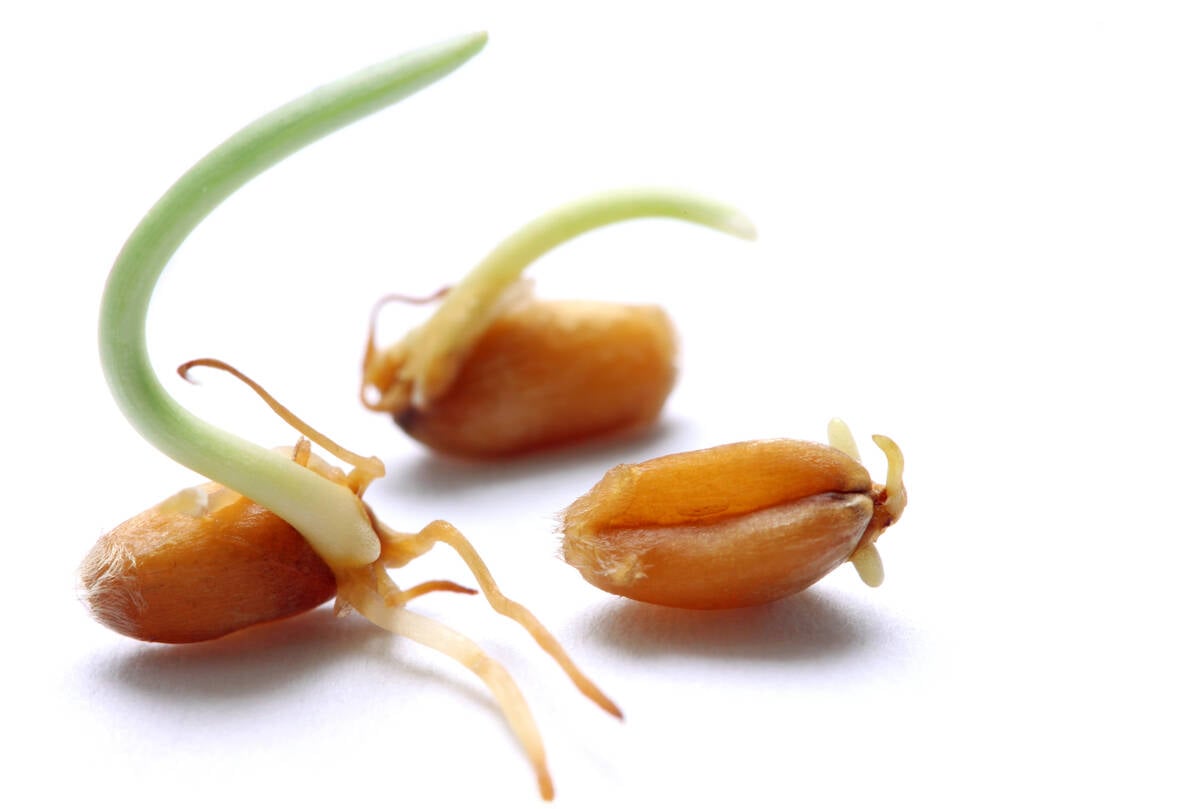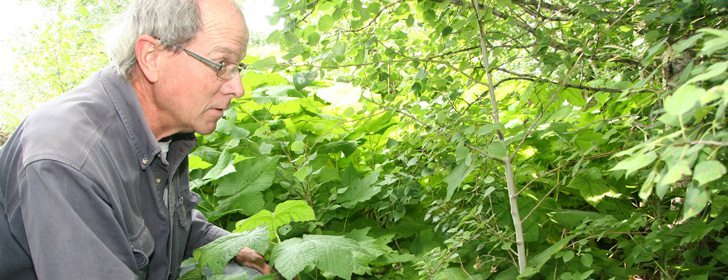SPRINGBANK, Alta. — Ken Wright carefully checks tiny saplings growing in a protected bed to decide which to pull and which ones might become mighty oaks.
The saplings are among the thousands of trees that Ken and Pam Wright grow from seed at their 16-acre nursery.
The oaks are grown from acorns collected from a heritage tree in Edmonton.
The Wrights have spent a lifetime growing trees and shrubs and are probably the only ones growing native species in this area.
“There is very little actual seed production in Alberta,” Ken said. “Most of the nurseries are ornamental with introduced plant material.”
Read Also

Manitoba farmers fight sprouted wheat after rain
Rain in mid-September has led to wheat sprouting problems in some Manitoba farm fields.
Growing local ensures greater plant survival and prevents the introduction of unwanted diseases and insects.
“That is our advantage in collecting seeds. We are not importing those things,” he said.
The Wrights learned their craft in Montana and ran a nursery in Cochrane, Alta., before selecting their current site at Springbank on the west side of Calgary. They have been at Bow Point Nurseries since 1988, gathering seeds and cuttings from the area to produce hardy native trees, shrubs, flowers and grasses.
It is a time consuming task that requires patience and wisdom.
“You need background knowledge in order to know propagation and then (know) what you do with a one-year-old pine and not lose it,” said Ken, whose background is botany.
Local knowledge of climate, altitude and soil is also needed because little research has been conducted on native tree production.
The nursery, with its 4,000 foot altitude, has cold nights and a short, dry growing season.
“We wanted to go somewhere where it was really hard to grow and tough and miserable because there has never been a research station or anything on the west side of Highway 2. This is the transition zone between the foothills and the prairie,” said Pam.
Seeds are started in flat containers in a greenhouse. Up to 500 trees may grow in a flat. They are thinned out a year later and eventually placed in plugs for customers.
Other trees, such as willows, are started from cuttings. Germination rates are 20 to 80 percent.
“It takes testing and trialing. Not everything grows,” Ken said.
They grow a wide variety of poplars, spruce, alders, aspens and junipers as well as wild flowers, grasses and shrubs such as the wild rose. The farmyard is full of native greenery that is welcoming and provides shelter from cold north winds or westerly chinooks.
The yard looks different every year as the canopies of plants and trees grow and change.
“It is designed to be successional and changing so as the overstory increases and the shade increases, the understory changes,” he said.
It is also meant to be pleasing year round.
“We have eight months of the year with no leaves so the plants really should have something to bring interest to the landscape,” Ken said.
That may come from trees with an interesting shape or colourful autumn leaves and bark like a dogwood, pussy willows and prairie sage.
The nursery is surrounded by country subdivisions, and developers have planted spruce and poplar because they grow fast and are consistent in size and shape. However, they may not always be the best choice, even for a windbreak.
“People plant spruce trees when there are so many other things to plant,” said Pam.
“They are conical, and anything conical, the wind just goes around, which means the sound goes around. Developers put them in because they can get consistent ones.”
The Wrights ship trees for windbreaks, reclamation projects and landscaping. They remind clients that trees and plants are no longer native outside the 100 kilometre range because the ecosystem is different. Alberta’s prairies, parklands, foothills and alpine regions are all unique ecosystems.
“Our advantage is we can ship in any direction from here,” Ken said.
Trees may go to Manitoba, Montana, British Columbia’s Lower Mainland, northern Alberta or moun-tain parks. A tree may grow three feet tall in Alberta but reach eight feet in B.C.
Trees will not grow in the hot and dry areas of southeastern Alberta, yet wildflowers and grasses thrive.
“There are parts of the province that are too cold, too windy, too harsh,” Ken said.
Added Pam: “It would take some really good quality plant material to do it, but a lot of people have just given up.”
Some customers may think it is more expensive to plant native trees and plants, but they are more likely to survive the conditions and live longer. Some local trees are probably 500 to 1,000 years old.
Prairie settlers brought plants from their homes that did not always succeed. They planted trees for shelter-belts in the 1930s, and many are starting to look bedraggled.
“Realistically, every 10 years you should put in another row just to keep it alive,” Ken said.
Planting native trees that are adapted to local diseases is another advantage. For example, this year’s wet conditions encouraged a canker called shepherd’s hook to grow on aspens.
“It is not abnormal. This plant evolved with this disease so technically it is not a disease because it is associated with the plant. It doesn’t affect the health and vigour of it. It grows past it,” he said.
The Wrights handle many large contracts, but they also work with local landscapers and gardeners seeking design and growing advice.
People tend to plant trees too deeply and then give them too much water.
“Overwatering is our most common call of what’s wrong with my tree. Ninety-five percent of the time, we can say stop watering,” said Ken.
The Wrights grow their trees in a mulched bed for the first year and water them once a month, even though home gardeners are reminded to give their trees plenty of water.
“Those are needy, high maintenance trees that are not programmed to live in this climate with our 14 inches of rain a year,” he said.
“We don’t have an irrigation system so we have to plan when is the best time for things to survive out here without any water.”
They plant in early spring or fall with more going in during the later season so the trees establish better. The ground is warmer but the days are cooler and the trees draw less moisture.
Xeriscaping is a popular landscaping trend, but Ken said it doesn’t have to be gravel, cacti and a few silver leafed plants.
“This whole nursery is xeriscaped. If you go to Banff, that is a xeriscape.Landscapes don’t need to be water-ed and shouldn’t be watered. They should be designed not to be watered. There is no reason to have an irrigation system if you plant it properly and use the right things.”
The Wrights are also low maintenance gardeners. However, they also said trees and shrubs can be pruned because in nature, wildlife nibbles on them and trims them back.
They also recommend proper planting distances because too often home landscapers plant trees too close together or too near fences or buildings. They suggest planting about 10 feet apart so the adults can touch.
“Trees touch in nature. Part of the trick with naturalizing is density,” he said.
They try new things each year and share their experiences.
“Everybody needs to be educated. It is the major thing we have to do in order to have a unique line of plants.”
The Wrights have a website and visitors are able to see a changing landscape that can survive drought and temperature swings. Sticking with natives offers predictability.
“From a farming standpoint, they are predictable,” Ken said.
“We know when we put seedlings in, in three years I am going to have this size of plants whether we have a dry cold winter or a wet winter or cold spring.”
They also want customer satisfaction and success.
“That’s our job — to fulfill people’s expectations. They buy plants and put them in the ground and there is always that optimism and vision,” he said.
For more information, visit www.bowpointnursery.com.
















